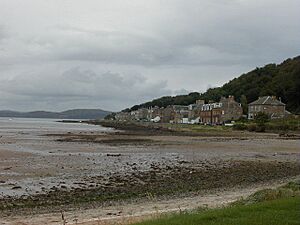Kilchattan Bay facts for kids
Quick facts for kids Kilchattan Bay |
|
|---|---|
 Kilchattan Bay |
|
| OS grid reference | NS102549 |
| Civil parish | |
| Council area | |
| Lieutenancy area | |
| Country | Scotland |
| Sovereign state | United Kingdom |
| Post town | ISLE OF BUTE |
| Postcode district | PA20 |
| Dialling code | 01700 |
| Police | Strathclyde |
| Fire | Strathclyde |
| Ambulance | Scottish |
| EU Parliament | Scotland |
| UK Parliament |
|
| Scottish Parliament | |
Kilchattan Bay is a small village located on the Isle of Bute in Scotland. It sits at the southern end of the island. The village is nestled at the base of a steep hill called Suidhe Chattan. This hill helps protect the village from strong westerly winds.
Kilchattan Bay faces east towards the mainland across the Firth of Clyde. To the north, there is a lovely sandy area known by locals as the Wee Bay. If you head south along the coast, you'll find the start of the West Island Way. This walking path follows the rocky shoreline and passes a lighthouse. The lighthouse marks the very southern tip of the island.
Contents
A Look Back at Kilchattan Bay's History
The village gets its name from Saint Cathan, a bishop from the sixth century. He set up a quiet retreat here in the year 539 AD. His nephew was Saint Blane. A chapel was built in Saint Blane's honor in the 12th century. The ruins of St. Blane's Chapel can still be seen about a mile south of Kilchattan village today.
Kilchattan Bay first grew as a row of houses for fishermen. Later, a quarry was built, along with a stone pier (a landing place for boats). A lime kiln was also added. You can still see the lime kiln behind St. Blane's Villa. The limestone used in the kiln was dug from the hillside behind the village. Part of the old mine area is now used as a reservoir, which holds water for the village. Above the reservoir, you can find the ruined remains of Kelspoke Castle.
Steamboats and Tourism
In 1880, a new wooden pier was built. This was because the village became a regular stop for steamers. These large boats brought visitors from the big city of Glasgow. They also carried local goods, like tiles from a factory in Kingarth (which closed in 1915). The St. Blane's Hotel was built between the two piers to serve the growing number of tourists.
Over time, the steamer traffic stopped. The new wooden pier closed to regular steamers in 1955. It was used sometimes after that, but the wood eventually broke down. The pier was taken apart in 1976.
In 1957, Queen Elizabeth II and her husband visited the island. They landed on the pier from the Royal Yacht Britannia before driving through the village. The older stone pier was stronger and has been repaired. It is now the main place for boats to land.
Village Life in the Past
Kilchattan Bay used to have many shops. There was a post office, a fabric shop, a bakery, a grocery store, a greengrocer, and a cafe. There was also a tearoom right at the pier. The cafe was owned by the family of singer Lena Zavaroni.
Until the early 1970s, Kilchattan Bay was one of the last places in Scotland where milk was delivered in a special way. Residents would bring their jugs to a van and collect milk directly from a large churn inside.
Recently, a landslide has washed away part of the path. This path led from the village to the top of Suidhe Chattan hill.
Notable People Connected to Kilchattan Bay
- Graeme Lamb - He often spent his holidays here.
- Ken W. MacDonald - He owns a home in the village.



